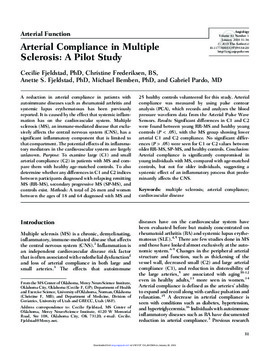| dc.contributor.advisor | | |
| dc.contributor.author | Cecilie Fjeldstad | |
| dc.contributor.author | Christine Frederiksen | |
| dc.contributor.author | Anette S. Fjeldstad | |
| dc.contributor.author | Michael G. Bemben | |
| dc.contributor.author | Gabriel Pardo | |
| dc.date.accessioned | 2016-01-14T19:53:24Z | |
| dc.date.accessioned | 2016-03-30T15:34:12Z | |
| dc.date.available | 2016-01-14T19:53:24Z | |
| dc.date.available | 2016-03-30T15:34:12Z | |
| dc.date.issued | 2010-02-01 | |
| dc.identifier.citation | Fjeldstad, C., Frederiksen, C., Fjeldstad, A. S., Bemben, M., & Pardo, G. (2010). Arterial Compliance in Multiple Sclerosis: A Pilot Study. Angiology, 61(1), 31-36. doi: 10.1177/0003319709334120 | en_US |
| dc.identifier.uri | https://hdl.handle.net/11244/25238 | |
| dc.description.abstract | A reduction in arterial compliance in patients with autoimmune diseases such as rheumatoid arthritis and systemic lupus erythematosus has been previously reported. It is caused by the effect that systemic inflammation has on the cardiovascular system. Multiple sclerosis (MS), an immune-mediated disease that exclusively affects the central nervous system (CNS), has a significant inflammatory component that is limited to that compartment. The potential effects of its inflammatory mediators in the cardiovascular system are largely unknown. Purpose: To examine large (C1) and small arterial compliance (C2) in patients with MS and compare them with healthy age-matched controls. To also determine whether any differences in C1 and C2 indices between participants diagnosed with relapsing remitting MS (RR-MS), secondary progressive MS (SP-MS), and controls exist. Methods: A total of 26 men and women between the ages of 18 and 64 diagnosed with MS and 25 healthy controls volunteered for this study. Arterial compliance was measured by using pulse contour analysis (PCA), which records and analyzes the blood pressure waveform data from the Arterial Pulse Wave Sensors. Results: Significant differences in C1 and C2 were found between young RR-MS and healthy young controls (P < .05), with the MS group showing lower arterial C1 and C2 compliance. No significant differences (P > .05) were seen for C1 or C2 values between older RR-MS, SP-MS, and healthy controls. Conclusion: Arterial compliance is significantly compromised in young individuals with MS, compared with age-matched controls, but not for older individuals, suggesting a systemic effect of an inflammatory process that predominantly affects the CNS. | en_US |
| dc.language.iso | en_US | en_US |
| dc.publisher | Angiology | |
| dc.subject | multiple sclerosis | en_US |
| dc.subject | arterial compliance | en_US |
| dc.subject | cardiovascular disease | en_US |
| dc.title | Arterial Compliance in Multiple Sclerosis: A Pilot Study | en_US |
| dc.type | Research Article | en_US |
| dc.description.peerreview | Yes | en_US |
| dc.description.peerreviewnotes | https://us.sagepub.com/en-us/nam/manuscript-submission-guidelines | en_US |
| dc.identifier.doi | 10.1177/0003319709334120 | en_US |
| dc.rights.requestable | false | en_US |
